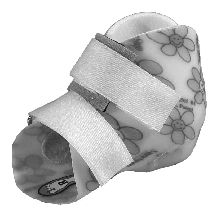
Kathy Martin PT DHS, Assistant Professor of Physical
Therapy, Krannert School of Physical Therapy, University of
Indianapolis, Indianapolis, USA.
Correspondence to author at Krannert School of Physical
Therapy, University of Indianapolis, Indianapolis, Indiana, USA.
E-mail: kmartin@uindy.edu
This study explored the effects of a flexible supramalleolar
orthosis (SMO), indicated to decrease pronation associated
with hypotonia, on postural stability in children with Down
syndrome. Seventeen children with Down syndrome (nine
males, eight females; mean age 5 years 10 months, SD 17.2
months; range 3 years 6 months to 8 years) were tested three
times in a 10-week period (weeks 1, 3, and 10) using the
Standing and the Walking, Running, and Jumping dimensions
of the Gross Motor Function Measure (GMFM), and the
Balance subtest of the Bruininks-Oseretsky Test of Motor
Proficiency (BOTMP). Range of motion measurements were
used to explore the influence of joint laxity. Significant
improvement was found with SMOs compared with shoes only
in the Standing dimension (p=0.001) and the Walking,
Running, and Jumping dimension (p=0.0001) of the GMFM,
both at the time of fitting (week 3) and after 7 weeks of
wearing SMOs (week 10). For the BOTMP Balance subtest,
significant improvement (p=0.027) was seen only at the end
of the 7-week study period. Amount of joint laxity did not
influence response to orthotic intervention. This study showed
that young children with Down syndrome showed immediate
and longer-term (after 7 weeks of use) improvement in
postural stability with the use of flexible SMOs.
Down syndrome, a genetic disorder occurring in 1.3 per 1000
live births in North America, is a common cause of neurodevelopmental
disability (Harris and Shea 1991) that includes
hypotonia, joint laxity, delayed achievement of motor milestones,
and disturbances in postural control (Rast and Harris
1985, Shumway-Cook and Woollacott 1985, Lauteslager et al.
1998, Russell et al. 1998). In a longitudinal study, Connolly et
al. (1993) found that children with Down syndrome continued
to have problems with postural stability into adolescence.
The neuropathology associated with Down syndrome, including
a smaller cerebellum and brainstem, is thought to be a factor
in these deficits (Shumway-Cook and Woollacott 1985,
Connolly et al. 1993).
Improving postural stability leads to better functional
motor performance (Westcott et al. 1997, Lauteslager et al.
1998). Anecdotal reports from physical therapists and parents
indicate that children with Down syndrome have improved
postural stability when they use orthoses. However, this belief
has not consistently been supported in the literature (Knutson
and Clark 1991). Only one study has investigated the use of
orthoses during gait in children with Down syndrome and it
showed decreased external rotation in the foot progression
angle, more consistent foot function during gait, and decreased
heel eversion in standing with foot orthoses (Selby-
Silverstein et al. 2001).
Genaze (2000) recommended supramalleolar orthoses
(SMOs) for children with Down syndrome as conventional foot
orthoses are usually not sufficient to control pronation secondary
to hypotonia and joint laxity; yet no study has investigated
the use of SMOs in children with Down syndrome. The
purpose of this study, therefore, was to determine the immediate
and longer-term effects of a flexible SMO on postural stability
and physical disability in children with Down syndrome.
In addition, the influence of joint laxity on response to the
orthoses was investigated. The primary research hypothesis
was that flexible SMOs would improve postural stability in
children with Down syndrome, as measured by dimensions
of the Gross Motor Function Measure (GMFM; Russell et al.
1993) and the Bruininks-Oseretsky Test of Motor Proficiency
(BOTMP; Bruininks 1978). Secondary hypotheses were that
this effect would be greater after several weeks of wearing the
orthoses and that children with Down syndrome with greater
joint laxity would benefit more from SMOs.
Method
PARTICIPANTS
Participants were recruited from central and northern Indiana,
USA through local parent support groups. They were eligible
for the study if they met the following criteria: aged between
3 years 6 months and 10 years; diagnosis of Down syndrome;
no parent-reported history of inner ear impairment or
uncorrected visual impairment; ability to follow simple commands;
no history of seizures; and independent ambulation
for 30 yards. This study was approved by the Committee on
Research Involving Human Participants at the University of
Indianapolis, USA. Informed, written consent was obtained
from a parent or guardian before participation in the study.
Seventeen children (nine males, eight females) with Down
syndrome participated in the study between July 2002 and
January 2003. Data from three children were eliminated from
the final analysis: one was unable to participate appropriately
in the testing, one did not tolerate the orthoses, and one was a low-scoring outlier on all dependent variables. For the 14
remaining participants, mean age at initial testing was 5 years
10 months (standard deviation [SD] 17.2 months) and range
was 3 years 6 months to 8 years.
To view the entire study Click here. It will open in a new window.